3D Electromagnetic Field Analysis Applied to Evaluate the Accuracy of a Voltage Transformer under Distorted Voltage
Abstract
1. Introduction
2. Construction of VT
3. Mathematical Model of VT
- The RMS values of a given higher harmonic in the input voltage of TVT: UTVThk.
- The RMS values of a given higher harmonic in the output voltage of DA: UDAhk.
- The phase shift of a given harmonic in the output voltage of DA in relation to the same frequency harmonic in the input voltage of TVT: φTVTDA.
4. Results of Computations and Tests
5. Conclusions
Author Contributions
Funding
Institutional Review Board Statement
Informed Consent Statement
Data Availability Statement
Conflicts of Interest
Appendix A
- Reference voltage divider (ςRVTkh\ςφRVThk):
- →
- 50 Hz: ±0.1%\±0.1°
- →
- 5 kHz: ±1%\±1°
- High impedance wideband converter of differential voltage to single ended voltage (δDAkh\ςφDAhk):
- →
- 50 Hz: ±1%\± 1°
- →
- 5 kHz: ±1%\±1°
- Digital power meter (δDPMkh\ςφDPMhk):
- →
- 50 Hz: ±0.15%\±0.3°
- →
- 5 kHz: ±2%\±3°
- Depending from Ukh:
- Depending from URVTkh:
- Depending from UDAkh:
- Depending from φRVThk:
- Depending from φDAhk:
- Depending from φDPMhk:
- Depending from Ukh:
- Depending from URVTkh:
- Depending from UDAkh:
- Depending from φRVThk:
- Depending from φDAhk:
- Depending from φDPMhk:
- → 50 Hz: ±0.02%\±0.02°
- → 5 kHz: ±0.1%\±0.1°
References
- Xu, W.; Liu, Y. A method for determining customer and utility harmonic contributions at the point of common coupling. IEEE Trans. Power Deliv. 2000, 15, 804–811. [Google Scholar] [CrossRef]
- Bajaj, M.; Singh, A.K.; Alowaidi, M.; Sharma, N.K.; Sharma, S.K.; Mishra, S. Power Quality Assessment of Distorted Distribution Networks Incorporating Renewable Distributed Generation Systems Based on the Analytic Hierarchy Process. IEEE Access 2020, 8, 145713–145737. [Google Scholar] [CrossRef]
- Filipović-Grčić, D.; Filipović-Grčić, B.; Krajtner, D. Frequency response and harmonic distortion testing of inductive voltage transformer used for power quality measurements. Procedia Eng. 2017, 202, 159–167. [Google Scholar] [CrossRef]
- Chen, Y.; Huang, Z.; Duan, Z.; Fu, P.; Zhou, G.; Luo, L. A Four-Winding Inductive Filtering Transformer to Enhance Power Quality in a High-Voltage Distribution Network Supplying Nonlinear Loads. Energies 2019, 12, 2021. [Google Scholar] [CrossRef]
- IEC\TR 61869-103. Instrument Transformers—The Use of Instrument Transformers for Power Quality Measurement; International Electrotechnical Commission: Geneva, Switzerland, 2012. [Google Scholar]
- IEC 61869-3. Instrument Transformers—Part 3: Additional Requirements for Inductive Voltage Transformers; International Electrotechnical Commission: Geneva, Switzerland, 2011. [Google Scholar]
- Dems, M.; Komeza, K.; Kubiak, W.; Szulakowski, J. Impact of Core Sheet Cutting Method on Parameters of Induction Motors. Energies 2020, 13, 1960. [Google Scholar] [CrossRef]
- Tong, Z.; Braun, W.D.; Rivas-Davila, J. Design and Fabrication of Three-Dimensional Printed Air-Core Transformers for High-Frequency Power Applications. IEEE Trans. Power Electron. 2020, 35, 8472–8489. [Google Scholar] [CrossRef]
- Lesniewska, E. Applications of the Field Analysis during Design Process of Instrument Transformers. In Transformers. Analysis, Design, and Measurement; Lopez-Fernandez, X.M., Ertan, B.H., Turowski, J., Eds.; CRC Press Taylor & Francis Group: Boca Raton, FL, USA; London, UK; New York, NY, USA, 2012; pp. 349–380. [Google Scholar]
- Lesniewska, E.; Rajchert, R. Application of the field-circuit method for the computation of measurement properties of current transformers with cores consisting of different magnetic materials. IEEE Trans. Magn. 2010, 46, 3778–3782. [Google Scholar] [CrossRef]
- Leśniewska, E.; Kowalski, Z. Designing voltage transformer insulation systems with SF6-insulations using CAD. Electr. Eng. 1991, 74, 427–432. [Google Scholar] [CrossRef]
- Leśniewska, E.; Olak, J. Improvement of the Insulation System of Unconventional Combined Instrument Transformer Using 3-D Electric-Field Analysis. IEEE Trans. Power Deliv. 2017, 33, 2582–2589. [Google Scholar] [CrossRef]
- Feng, Z.; Chunyang, J.; Min, L.; Fuchang, L.; Shihai, Y.; Zhou, F.; Jiang, C.; Lei, M.; Lin, F.; Yang, S. Development of ultrahigh-voltage standard voltage transformer based on series voltage transformer structure. IET Sci. Meas. Technol. 2019, 13, 103–107. [Google Scholar] [CrossRef]
- Leal, A.C.; Trujillo, C.; Piedrahita, F.S. Comparative of Power Calculation Methods for Single-Phase Systems under Sinusoidal and Non-Sinusoidal Operation. Energies 2020, 13, 4322. [Google Scholar] [CrossRef]
- Mingotti, A.; Peretto, L.; Tinarelli, R. Calibration Procedure to Test the Effects of Multiple Influence Quantities on Low-Power Voltage Transformers. Sensors 2020, 20, 1172. [Google Scholar] [CrossRef]
- Faifer, M.; Laurano, C.; Ottoboni, R.; Toscani, S.; Zanoni, M. Harmonic Distortion Compensation in Voltage Transformers for Improved Power Quality Measurements. IEEE Trans. Instrum. Meas. 2019, 68, 3823–3830. [Google Scholar] [CrossRef]
- Kaczmarek, M.; Stano, E. Proposal for extension of routine tests of the inductive current transformers to evaluation of transformation accuracy of higher harmonics. Int. J. Electr. Power Energy Syst. 2019, 113, 842–849. [Google Scholar] [CrossRef]
- Szewczyk, M.; Kutorasinski, K.; Pawlowski, J.; Piasecki, W.; Florkowski, M. Advanced Modeling of Magnetic Cores for Damping of High-Frequency Power System Transients. IEEE Trans. Power Deliv. 2016, 31, 2431–2439. [Google Scholar] [CrossRef]
- Markovic, M.; Perriard, Y. Eddy current power losses in a toroidal laminated core with rectangular cross section. In Proceedings of the 12th International Conference on Electrical Machines and Systems, Tokyo, Japan, 15–18 November 2009; pp. 1–4. [Google Scholar]
- Diez, P.; Webb, J.P. A Rational Approach to B-H Curve Representation. IEEE Trans. Magn. 2016, 52, 1–4. [Google Scholar] [CrossRef]
- Asghari, B.; Dinavahi, V.; Rioual, M.; Martinez, J.A.; Iravani, R. Interfacing Techniques for Electromagnetic Field and Circuit Simulation Programs IEEE Task Force on Interfacing Techniques for Simulation Tools. IEEE Trans. Power Deliv. 2009, 24, 939–950. [Google Scholar] [CrossRef]
- Leśniewska, E.; Rajchert, R. Influence of different load of the secondary winding on measurement properties of current transformers with core made from different magnetic materials. IET Sci. Meas. Technol. 2019, 13, 44–948. [Google Scholar] [CrossRef]
- Lesniewska, E.; Jalmuzny, W. The estimation of metrological characteristics of instrument transformers in rated and overcurrent conditions based on the analysis of electromagnetic field. Int. J. Comput. Math. Electr. Electron. Eng. 1992, 11, 209–912. [Google Scholar] [CrossRef]
- Lesniewska, E.; Jalmuzny, W. Influence of the number of core air gaps on transient state parameters of TPZ class protective current transformers. IET Sci. Meas. Technol. 2009, 3, 105–112. [Google Scholar] [CrossRef]
- Lesniewska, E.; Jalmuzny, W. Influence of the correlated location of cores of TPZ class protective current transformers on their transient state parameters. In Studies in Applied Electromagnetics and Mechanics; IOS Press Ebook Advanced Computer Techniques in Applied Electromagnetics: Amsterdam, The Netherlands, 2008; Volume 30, pp. 231–239. [Google Scholar]
- Kaczmarek, M. Development and application of the differentia voltage to single ended voltage converter to determine the composite error of voltage transformers and dividers for transformation of sinusoidal and distorted voltages. Meas. J. Int. Meas. Confed. 2017, 101, 53–61. [Google Scholar] [CrossRef]
- Kaczmarek, M.; Kaczmarek, P. Comparison of the Wideband Power Sources Used to Supply Step-Up Current Transformers for Generation of Distorted Currents. Energies 2020, 13, 1849. [Google Scholar] [CrossRef]
- Kaczmarek, M.; Szatilo, T. Reference voltage divider designed to operate with oscilloscope to enable determination of ratio error and phase displacement frequency characteristics of MV voltage transformers. Meas. J. Int. Meas. 2015, 68, 22–31. [Google Scholar] [CrossRef]
- Kaczmarek, M. The effect of distorted input voltage harmonics rms values on the frequency characteristics of ratio error and phase displacement of a wideband voltage divider. Electr. Power Syst. Res. 2019, 167, 1–8. [Google Scholar] [CrossRef]
- EN 50160. Voltage Characteristics of Electricity Supplied by Public Distribution Systems; European Committee for Electrotechnical Standardization CENELEC: Brussels, Belgium, 2007. [Google Scholar]
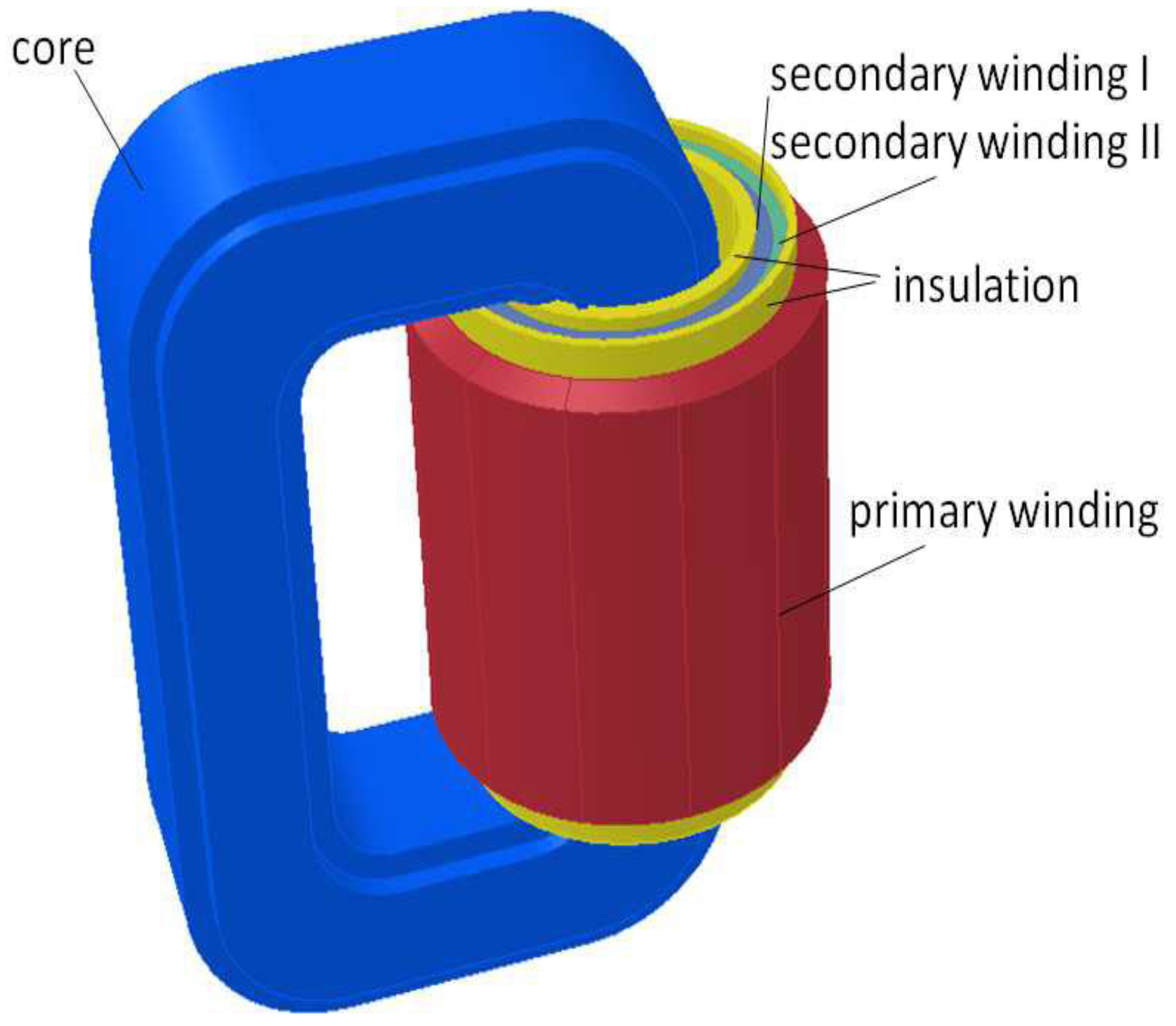
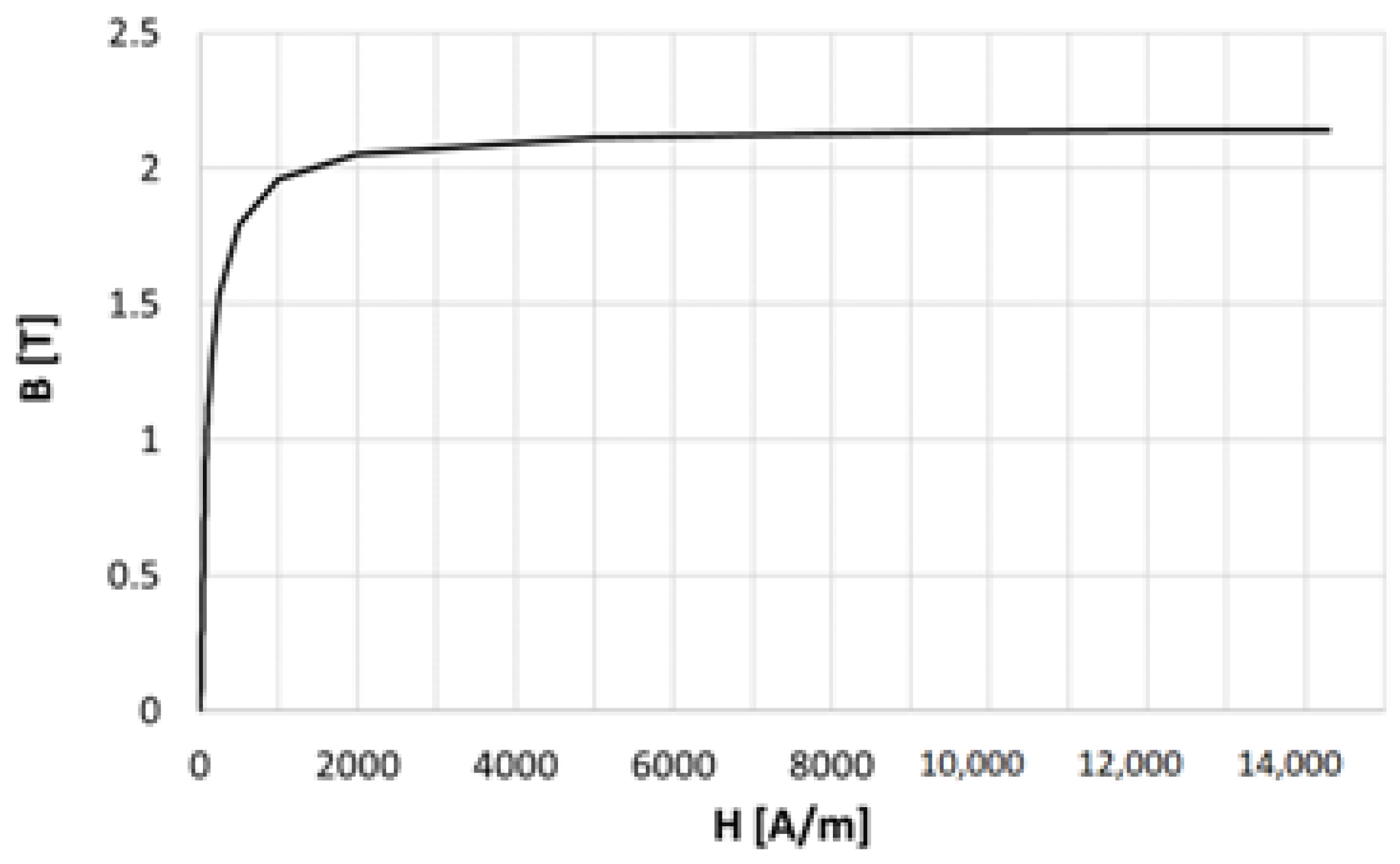
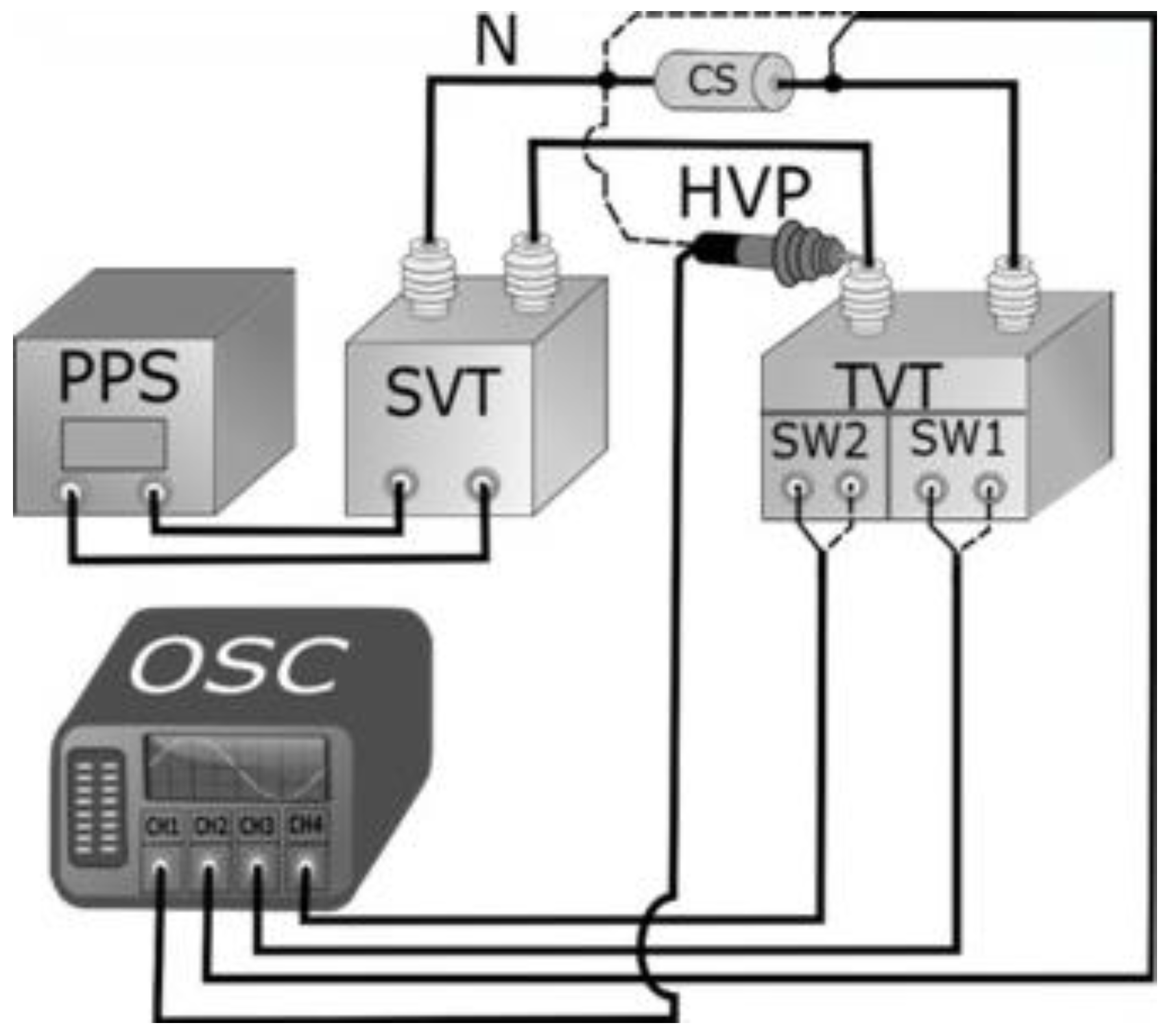
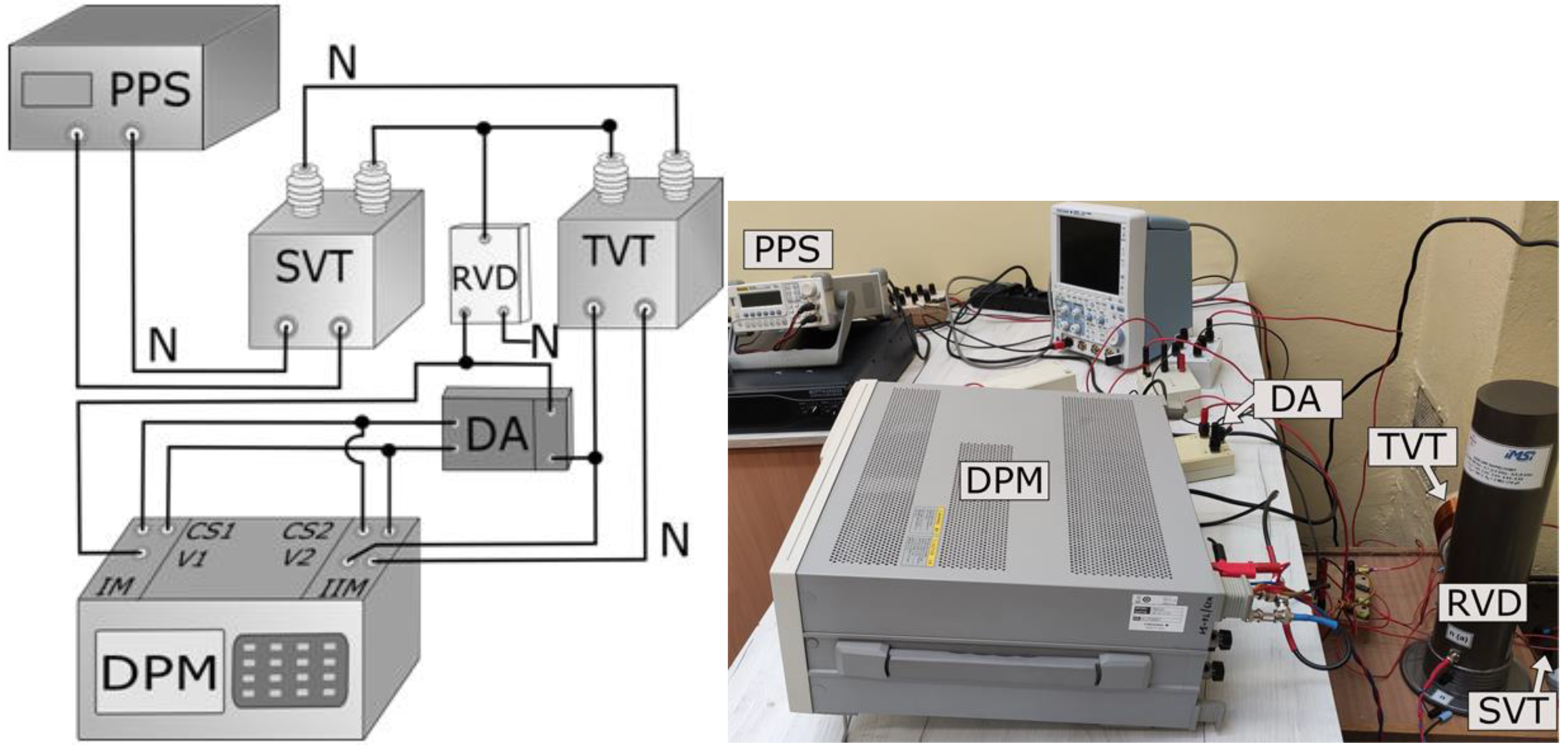
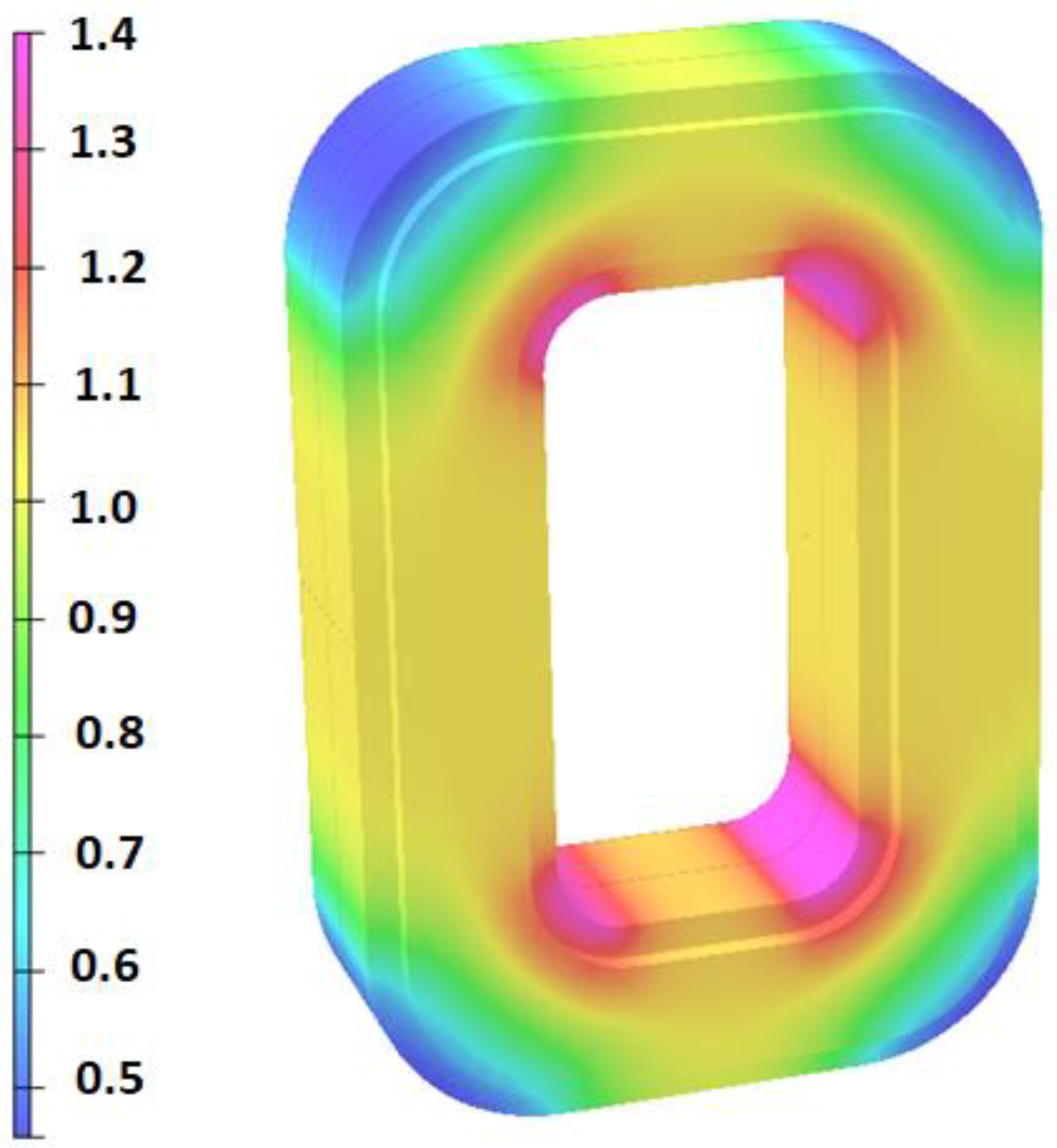
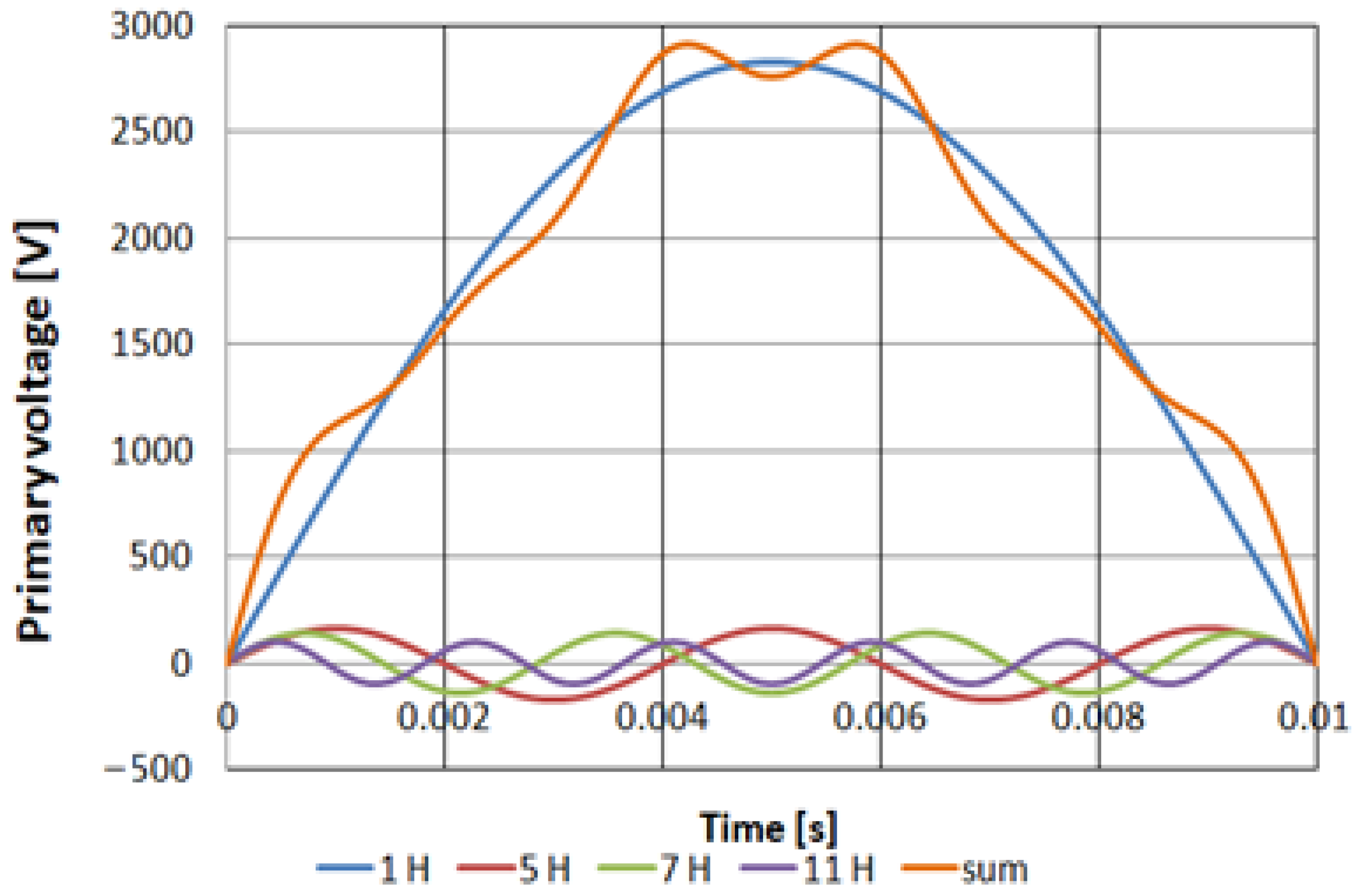
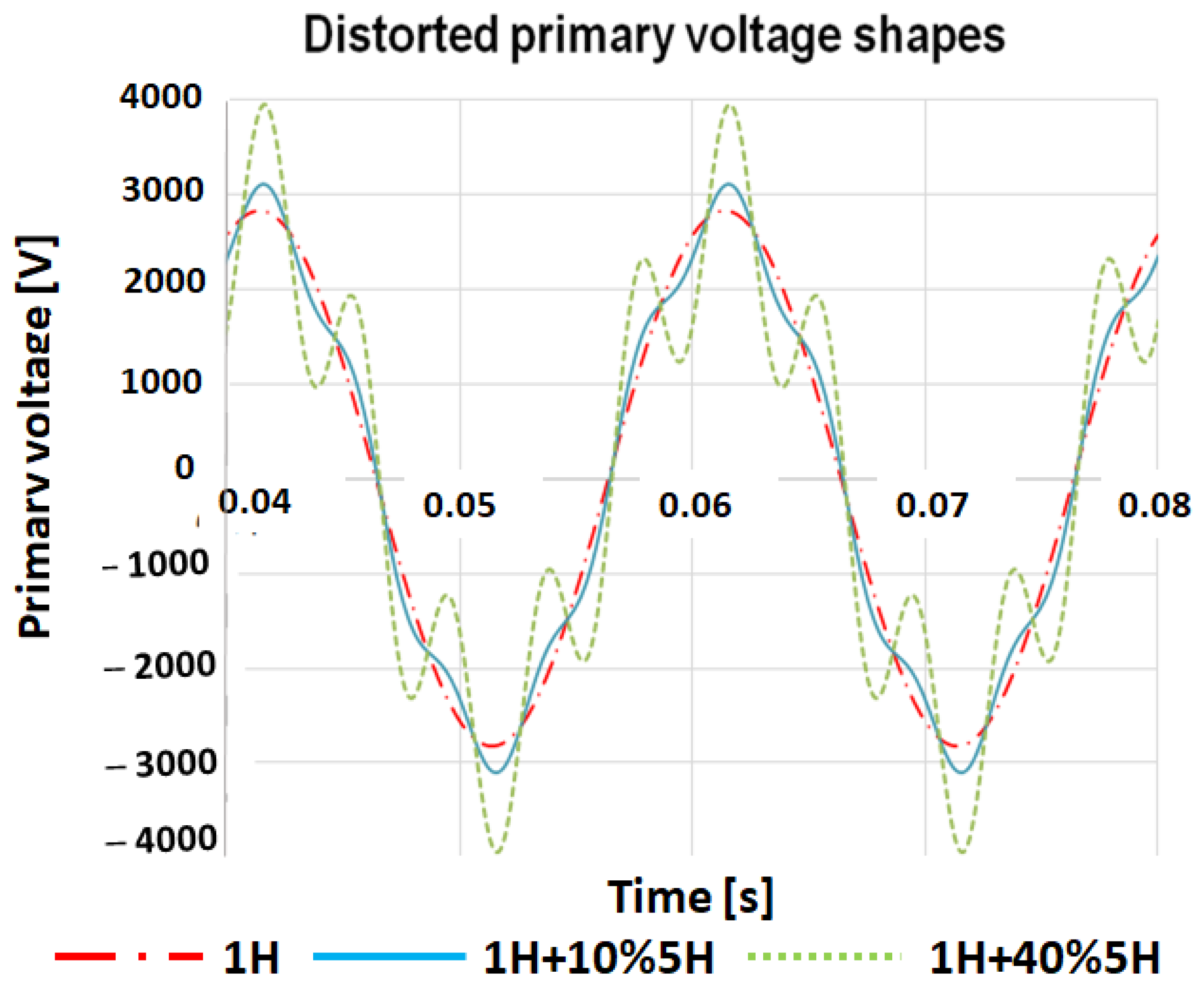
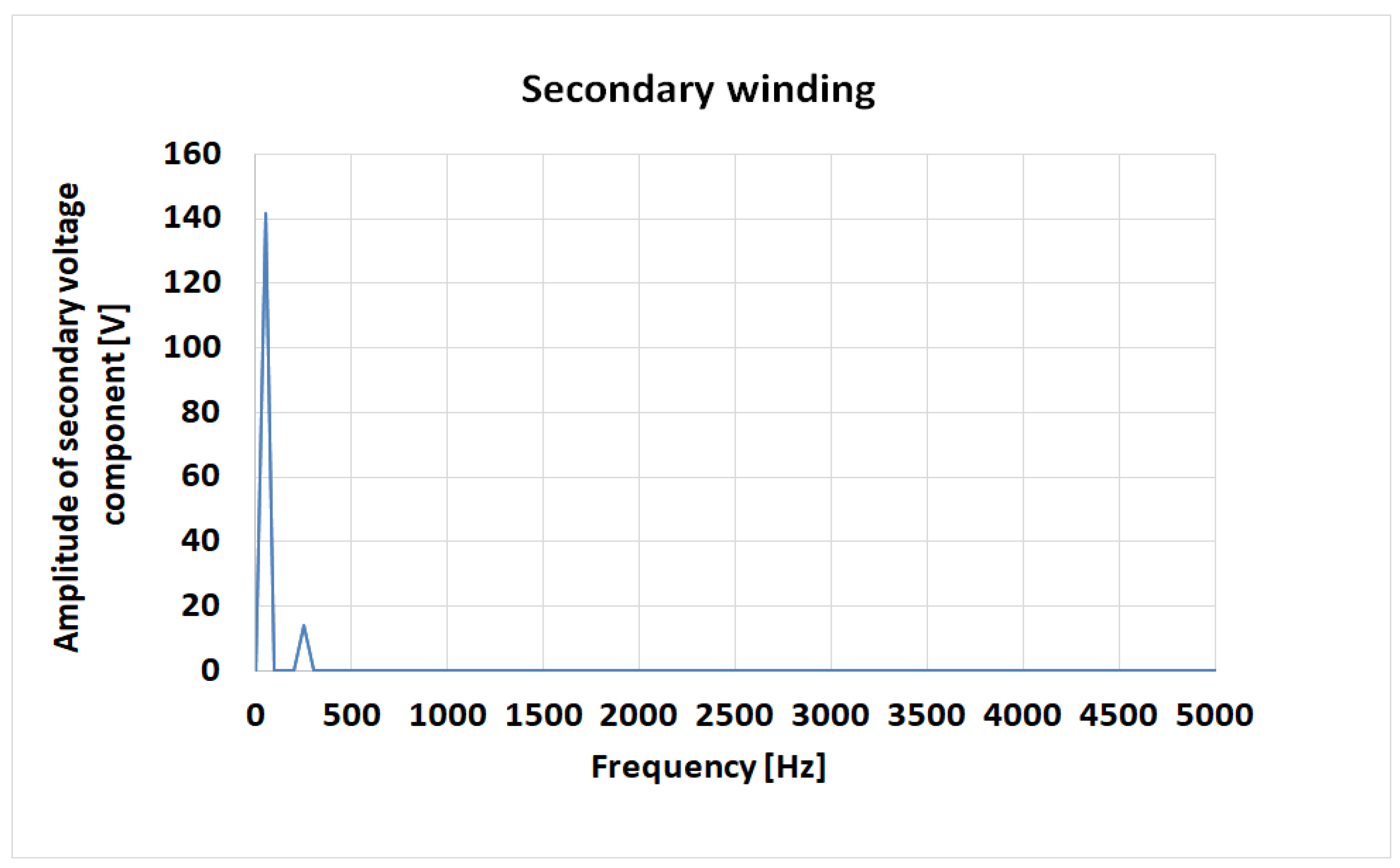
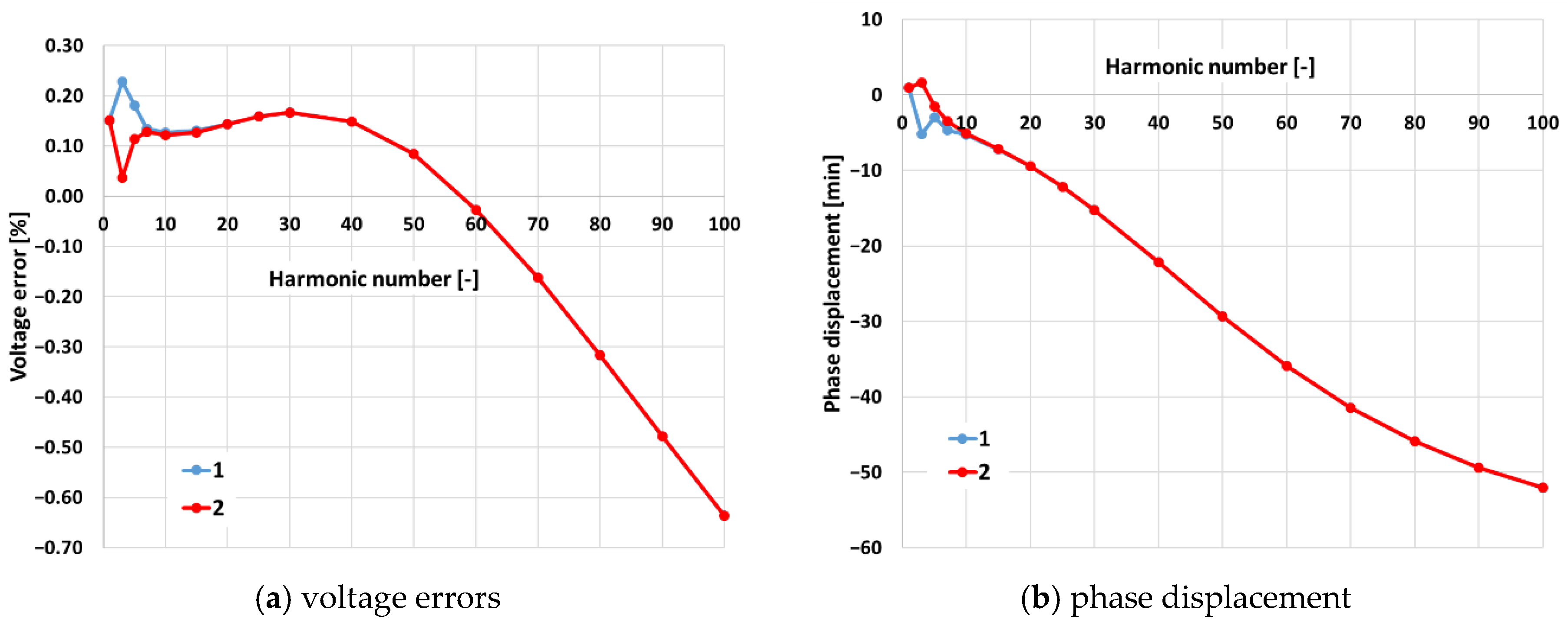
| Uncertainty of Measurement | Voltage Errors | Phase Displacement |
|---|---|---|
| 50 Hz | ±0.02% | ±0.02° |
| 250 Hz | ±0.05% | ±0.05° |
| Primary Voltage 100% UN | Secondary Winding I | |
|---|---|---|
| Measurement | Computation | |
| Voltage errors [%] | 0.15 | 0.15 |
| Phase displacement [min] | 0.9 | 2.4 |
| Transformation Errors | Secondary Winding I | |
|---|---|---|
| Measurement | Computation | |
| Primary voltage 100% UN | ||
| Voltage errors [%] | 0.15 | 0.15 |
| Phase displacement [min] | 0.93 | 2.4 |
| Primary voltage 100% UN+10%5H | ||
| Voltage errors [%] | 0.15 | 0.14 |
| Phase displacement [min] | −0.15 | −0.69 |
| Primary voltage 100% UN+40%5H | ||
| Voltage errors [%] | — | 0.13 |
| Phase displacement [min] | — | −0.14 |
| Secondary Winding I | Voltage Errors [%] | Phase Displacement [min] |
|---|---|---|
| Primary voltage 100% UN | 0.15 | 0.9 |
| Primary voltage 10% 5H | 0.18 | −2.9 |
| Primary voltage 100% UN+10% 5H | 0.15 | −0.15 |
Publisher’s Note: MDPI stays neutral with regard to jurisdictional claims in published maps and institutional affiliations. |
© 2020 by the authors. Licensee MDPI, Basel, Switzerland. This article is an open access article distributed under the terms and conditions of the Creative Commons Attribution (CC BY) license (http://creativecommons.org/licenses/by/4.0/).
Share and Cite
Lesniewska, E.; Kaczmarek, M.; Stano, E. 3D Electromagnetic Field Analysis Applied to Evaluate the Accuracy of a Voltage Transformer under Distorted Voltage. Energies 2021, 14, 136. https://doi.org/10.3390/en14010136
Lesniewska E, Kaczmarek M, Stano E. 3D Electromagnetic Field Analysis Applied to Evaluate the Accuracy of a Voltage Transformer under Distorted Voltage. Energies. 2021; 14(1):136. https://doi.org/10.3390/en14010136
Chicago/Turabian StyleLesniewska, Elzbieta, Michal Kaczmarek, and Ernest Stano. 2021. "3D Electromagnetic Field Analysis Applied to Evaluate the Accuracy of a Voltage Transformer under Distorted Voltage" Energies 14, no. 1: 136. https://doi.org/10.3390/en14010136
APA StyleLesniewska, E., Kaczmarek, M., & Stano, E. (2021). 3D Electromagnetic Field Analysis Applied to Evaluate the Accuracy of a Voltage Transformer under Distorted Voltage. Energies, 14(1), 136. https://doi.org/10.3390/en14010136







